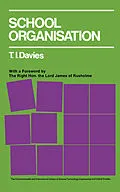School Organisation: A New Synthesis tackles the complexities of the time-table using techniques that are becoming normal in many fields of activity but offer fresh perspectives on school organization. This book examines the purely practical problem of putting into concrete terms of hours of teaching and use of staff the deeper decisions that rest on judgements of value and personality. This monograph is comprised of 14 chapters and opens with an overview of several possible approaches to the study of school organization. The discussion then turns to a perspective in which school organization appears as a process of grouping: a grouping of pupils into schools, into year groups in schools, into forms, into option groups, or into subject classes. Two fundamental concepts that pervade the whole complex of number relationships are described, namely, the notion of numerical value and the idea of pattern or form. Subsequent chapters focus on the use of notation as a thinking aid; the art of school organization; the laws of the curriculum; and the role of the administrator in school organization. This text will be of interest to students, educators, school administrators, and educational policymakers as well as those involved in the intricate practical tasks of school organization.
Inhalt
Foreword
Preface
1. Introduction
2. A New Curricular Notation
3. The Notation as a Thinking Aid
4. Conversion Units
5. Freedom of Choice
6. The Art of School Organization
7. Groups in the School
8. The Average Class Size
9. The Laws of the Curriculum
10. The School's Long Section
11. The Completed School Model: A Case Study
12. A Further Case Study
13. The Time-Tabling Task
14. The Administrator's Role
Tables I. Staff-loading Norms (Wales, 1966)
Tables II. Bonus Allocation to Schools (Wales, 1966)
Tables IIIA. Average Class Size (Main School)
Tables IIIB. Average Class Size (Sixth Form)
Tables IV. Bonus Distribution among Year Groups (Wales, 1966)
Index
